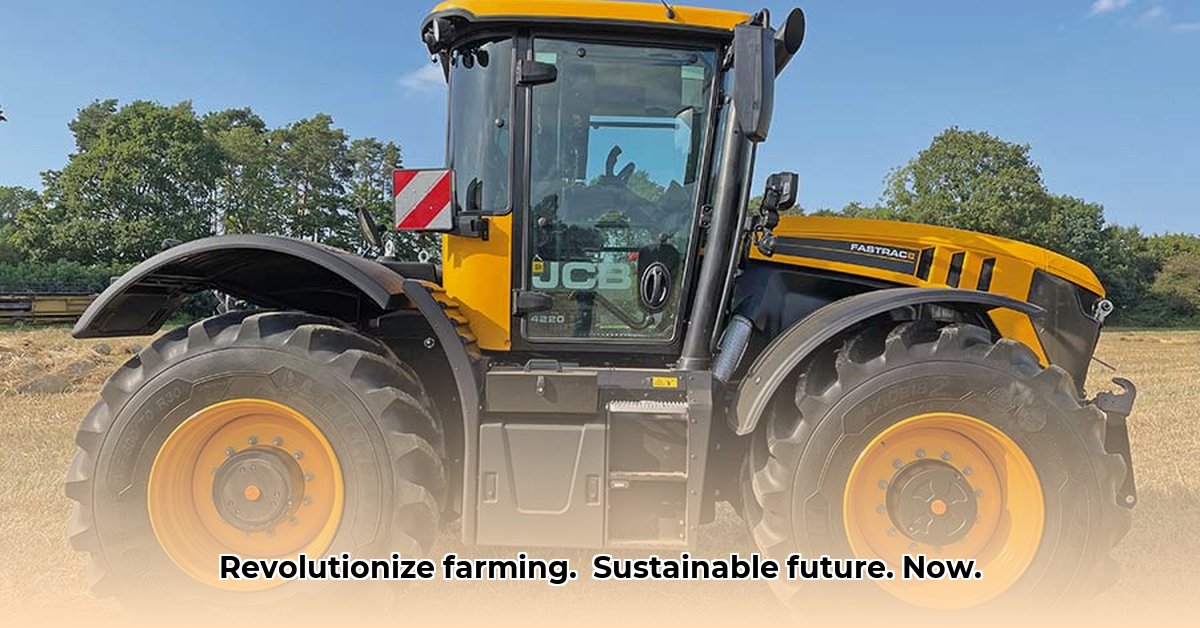
Speed and Efficiency: Redefining Agricultural Productivity
The agricultural landscape is evolving rapidly, demanding increased efficiency and sustainability. High-speed tractors, like the JCB Fastrac, offer a potential solution, promising to revolutionize farming practices. But is this technological leap truly beneficial for both productivity and environmental stewardship? This analysis delves into the Fastrac's capabilities, exploring its advantages and limitations within the context of sustainable agriculture. For more details on the JCB Fastrac, visit the official website.
One of the Fastrac's most notable features is its impressive speed—up to 43 mph (depending on model and regulations)—significantly exceeding traditional tractors. This translates into substantial productivity gains, allowing farmers to cover more acreage in less time. This increased efficiency directly impacts labor costs and overall farm output. But speed isn't the only factor; the Fastrac's advanced full front and rear suspension minimizes soil compaction, a significant benefit for long-term soil health and crop yields. Healthier soil equates to healthier plants and improved sustainability.
Could this increased speed lead to reduced fuel consumption per unit of work? While intuitively appealing, this requires rigorous testing and data analysis, currently unavailable. This lack of comprehensive fuel efficiency data is pivotal for a holistic sustainability assessment.
Operator Comfort and Technological Advancements
Beyond speed and efficiency, the Fastrac prioritizes operator comfort. Its centrally mounted cab, combined with its advanced suspension system, reduces operator fatigue and enhances focus. A comfortable working environment is crucial for both productivity and worker well-being, vital components of sustainable farming practices. Furthermore, the improved operator experience contributes to enhanced safety, mitigating risks associated with long hours in the field. These factors contribute to a more sustainable farming model, by improving both the health and productivity of the workforce.
However, despite technological advancements like the external disc brakes (designed for enhanced braking performance, longer brake life, and reduced downtime), the high initial cost and potential for higher maintenance costs remain considerations. A deeper investigation into long-term maintenance needs through independent assessments would increase transparency and build trust.
Sustainability Considerations and Cost Analysis
While the Fastrac presents several advantages, a complete sustainability assessment requires comprehensive data on long-term fuel consumption, lifecycle analysis (LCA) encompassing manufacturing and disposal, and precise greenhouse gas emission measurements. This information is currently lacking, hindering the definitive evaluation of its environmental impact. Transparency in this area is critical for responsible adoption.
The Fastrac's high purchase price presents a significant barrier for smaller farms with tighter operating margins. The return on investment (ROI) depends heavily on factors such as farm size, crop type, and existing financial resources. Therefore, independent economic analyses are crucial to determine the economic feasibility of this technology across various contexts. Understanding the long term financial implications is critical for this tractor's sustainability.
Stakeholder Perspectives and Risk Mitigation
The Fastrac's impact varies depending on the stakeholder's perspective:
- Large Farms: See potential for significant ROI increases through efficiency gains and pilot programs leading to wider adoption.
- Medium Farms: Require thorough cost-benefit analyses and exploration of financing options for gradual adoption.
- Small Farms: Face affordability challenges and need to evaluate alternative options or explore equipment-sharing programs.
- Government Agencies: Can support research assessing environmental impact and implement policies incentivizing the adoption of sustainable technologies.
- JCB & Competitors: Need to provide publicly available LCA data and demonstrate a commitment to sustainable manufacturing practices and continued R&D.
Potential risks associated with the Fastrac include:
- High Initial Cost: Mitigated through leasing, financing, or gradual upgrades.
- Maintenance Costs: Mitigated through preventative maintenance and service contracts.
- Technological Dependence: Mitigated through robust operator training and backup equipment.
- Data Transparency Deficit: Addressed through demand for independent studies and transparent reporting by manufacturers.
Navigating the Regulatory and Technological Landscape
The regulatory environment surrounding agricultural practices continues evolving. Future emissions regulations and sustainable farming policies will influence the adoption rate of high-speed tractors. Collaboration between farmers, manufacturers, and regulatory bodies is crucial to ensure these technologies contribute positively to long-term environmental sustainability. The future of sustainable agriculture will depend on collaboration and well-informed policy.
Conclusion: A Balanced Perspective
The JCB Fastrac represents a significant advancement in agricultural technology, offering the potential for increased efficiency and reduced soil compaction. However, its high cost and the absence of comprehensive sustainability data necessitate careful consideration. Thorough cost-benefit analysis, coupled with a transparent assessment of its environmental impact, is essential before widespread adoption. Data-driven decisions, grounded in transparency, are critical for navigating the transition to sustainable agricultural practices. The future of farming may incorporate high-speed tractors, but informed, strategic adoption is paramount.